Телескопические покрытия – что это и почему они важны?

Телескопические кожухи – это защитные элементы, используемые в промышленных станках, предназначенные для защиты движущихся частей от загрязнений, механических повреждений и преждевременного износа. Благодаря своей конструкции они эффективно защищают направляющие, ходовые винты и другие компоненты, отвечающие за точную работу устройств.
Телескопические кожухи – что это и почему они важны?
Использование телескопических кожухов необходимо в металлообрабатывающей промышленности, производстве с ЧПУ и многих других отраслях, где станки работают в сложных условиях. Телескопические кожухи не только продлевают срок службы станков, но и снижают риск поломок, что приводит к снижению затрат на обслуживание и повышению производительности.
Телескопические кожухи в промышленных станках
Телескопические кожухи играют важную роль в защите механизмов станков от внешних воздействий. Их задачи:
Защита от пыли, стружки и жидкостей – в процессе механической обработки образуются мелкие стружки и охлаждающие жидкости, которые могут негативно сказаться на работе станков. Телескопические кожухи эффективно блокируют доступ этих загрязнителей.
Предотвращение механических повреждений направляющих – промышленные станки работают с высокой точностью, и даже незначительные повреждения направляющих могут повлиять на качество обработки. Телескопические кожухи минимизируют этот риск.
Снижение эксплуатационных затрат – защита компонентов станка означает более редкое техническое обслуживание и замену деталей, что снижает затраты на ремонт и простои в производстве.
Повышение безопасности оператора – хорошо спроектированные телескопические кожухи предотвращают случайный контакт работников с движущимися частями станка, повышая безопасность на рабочем месте.
Материалы, используемые при производстве телескопических кожухов
Телескопические кожухи могут изготавливаться из различных материалов, но наиболее часто используются:
Нержавеющая сталь – особенно рекомендуется в условиях, где используется большое количество смазочно-охлаждающих жидкостей. Нержавеющая сталь устойчива к коррозии, что обеспечивает длительный срок службы даже в сложных условиях.
Чугун – используется реже, но все же применяется в некоторых случаях. Он тяжелее стали, но обладает высокой износостойкостью и механической стабильностью.
Алюминиевые сплавы и другие металлы – в некоторых случаях используются легкие металлы, особенно там, где масса кожуха важна для динамики движения станка.
Выбор материала зависит от условий работы станка и окружающей среды, в которой будет использоваться кожух.
Аксессуары для обеспечения надлежащей работы
Чтобы телескопические кожухи эффективно выполняли свою функцию, они часто оснащаются дополнительными компонентами, улучшающими их долговечность и эксплуатационные характеристики. К основным аксессуарам относятся:
- Скользящие накладки – уменьшают трение и обеспечивают плавное движение кожуха.
- Ролики и направляющие – позволяют кожухам двигаться точно и легко, что особенно важно для быстрых станков.
- Амортизаторы – снижают ударную нагрузку между сегментами кожуха, продлевая его срок службы.
- Маслоотделители и очистители – удаляют излишки охлаждающей жидкости, масла и загрязнений с направляющих, предотвращая их попадание внутрь кожуха.
Благодаря правильному подбору материалов и аксессуаров телескопические кожухи могут надежно работать в течение длительного времени, эффективно защищая компоненты станков и обеспечивая их надежность.
Производство телескопических кожухов
Производство телескопических кожухов – это процесс, требующий точного подхода и полной адаптации к специфическим требованиям заказчиков. Каждый станок, его рабочие условия и требования различны, поэтому проектирование и производство кожухов должны быть гибкими, чтобы соответствовать этим индивидуальным ожиданиям. Компании, занимающиеся производством телескопических кожухов, такие как Metal Gennari, отвечают на эти потребности, создавая индивидуальные решения и обеспечивая высокое качество изготовления.
Каждый телескопический кожух проектируется с учетом характеристик станка, на котором он будет использоваться. Процесс проектирования начинается с тщательного анализа требований заказчика, рабочих условий станка и особых нужд, таких как скорость движения или наличие смазочно-охлаждающих веществ. На основе этого создаются решения, которые будут не только эффективными, но и долговечными.
Конструкторы адаптируют форму, размеры и материалы кожухов в соответствии с требованиями конкретного применения. Благодаря такому индивидуальному подходу телескопические кожухи становятся оптимальным решением для защиты станков, минимизации эксплуатационных затрат и максимизации безопасности и эффективности производства.
Важность точности и качества материалов
Качество материалов, используемых при производстве телескопических кожухов, имеет решающее значение для их производительности и долговечности. Высококачественные материалы не только обеспечивают лучшую защиту от механических повреждений и загрязнений, но и увеличивают устойчивость к коррозии, износу и другим сложным рабочим условиям.
В случае крупных промышленных станков, где кожухи должны работать в сложных условиях (например, при высоких скоростях скольжения или интенсивном использовании смазочно-охлаждающих жидкостей), особенно важно использовать материалы, устойчивые к коррозии и высоким температурам. По этой причине нержавеющая сталь является одним из самых популярных материалов для производства телескопических кожухов. Кроме того, точное производство и правильная обработка материалов гарантируют надежность кожуха в течение длительного периода эксплуатации.
Примеры телескопических кожухов из нержавеющей стали
Нержавеющая сталь – это идеальный материал для телескопических кожухов, работающих в среде с высоким содержанием смазочно-охлаждающих жидкостей. Благодаря своей коррозионной стойкости нержавеющая сталь обеспечивает долговечность кожухов даже в сложных промышленных условиях. Компания Metal Gennari, производящая телескопические кожухи, предлагает решения из этого материала, адаптированные к требованиям клиентов по форме, размеру и условиям работы станков.
Примером может служить телескопический кожух из нержавеющей стали для металлообрабатывающего станка, который работает в условиях высокой влажности и интенсивного использования охлаждающей жидкости. Благодаря использованию нержавеющей стали кожух обеспечивает защиту от коррозии, а его конструкция подходит для высоких нагрузок и частых движений. Телескопические кожухи из нержавеющей стали также легко чистить и обслуживать, что способствует их долговечности и надежности.
Ремонт телескопических кожухов
Ремонт телескопических кожухов – это важный процесс, который продлевает их срок службы и поддерживает машины в рабочем состоянии, минимизируя риск поломок и сопутствующих затрат. Профессиональная диагностика и экспертный ремонт являются ключом к поддержанию высокой эффективности кожухов, особенно в промышленной среде, где телескопические кожухи играют важную роль в защите оборудования.
Диагностика и объем возможного ремонта
Процесс ремонта телескопических кожухов начинается с тщательной диагностики, которая помогает выявить повреждения и оценить техническое состояние кожуха. Специалисты компаний, занимающихся такими ремонтами, например Metal Gennari, проводят детальный осмотр, чтобы определить, какие компоненты кожуха нуждаются в ремонте или замене.
В зависимости от степени износа и типа повреждений ремонт может включать различные работы. Механические повреждения или износ материалов, например, из-за трения, могут потребовать замены уплотнений, роликов или амортизаторов. В свою очередь, проблемы, вызванные износом из-за смазочных материалов, могут потребовать замены защитных элементов, таких как маслосъемники или направляющие. Проведение комплексного ремонта восстанавливает кожух до полной функциональности.
Какие компоненты можно заменить в телескопических кожухах?
Во время ремонта телескопических кожухов можно заменить множество ключевых компонентов, которые подвержены повреждению в процессе эксплуатации. Вот некоторые из них:
• Маслосъемники: Телескопические кожухи, оснащенные маслосъемниками (латунными или ПВХ), помогают удалять излишки масла, предотвращая его накопление и осаждение. Замена изношенных маслосъемников – одна из наиболее распространенных ремонтных задач.
• Ролики и амортизаторы: Эти компоненты обеспечивают плавное движение кожуха. Со временем они могут изнашиваться, а их замена восстанавливает оптимальную работоспособность телескопического кожуха.
• Направляющие и другие аксессуары: Поврежденные направляющие или другие конструктивные элементы также могут быть отремонтированы путем замены. Правильное направление телескопических элементов критически важно для эффективности кожуха.
Ремонт телескопических кожухов позволяет точно настроить компоненты в зависимости от степени износа, обеспечивая их долговечную и надежную работу.
Тестирование и быстрая доставка после ремонта
После завершения ремонта все телескопические кожухи проходят тщательное тестирование для проверки их функциональности и долговечности. Компании, такие как Metal Gennari, используют симуляторы и испытательные стенды, позволяющие проводить испытания в условиях, максимально приближенных к реальным. Это гарантирует выявление возможных отклонений и безупречную работу отремонтированных кожухов.
После завершения тестирования отремонтированный телескопический кожух готов к быстрой отправке клиенту. В большинстве случаев время ремонта составляет всего несколько дней, что помогает минимизировать простой оборудования и сохранить непрерывность работы промышленных машин. Быстрая доставка – важный элемент комплексного обслуживания, особенно в ситуациях, когда время критично.
Специальные области применения телескопических кожухов
Телескопические кожухи незаменимы во многих промышленных секторах, и их роль заключается не только в защите машин от загрязнений, но и в обеспечении их долгосрочной и бесперебойной работы. По мере развития станков и промышленного оборудования возникают новые требования к конструкции телескопических кожухов. Адаптация этих кожухов к новым технологиям важна для поддержания их эффективности в быстро меняющихся рабочих условиях.
Как адаптировать кожухи к современным станкам?
Современные станки часто требуют телескопических кожухов, соответствующих повышенным требованиям, связанным с скоростью работы и специфическими условиями эксплуатации. Поэтому телескопические кожухи должны быть адаптированы к параметрам, таким как изменяющаяся скорость движения, большое количество охлаждающих жидкостей и сложные процессы, происходящие в станках.
Проектирование телескопических кожухов для современных машин начинается с детального анализа потребностей заказчика. Необходимо учитывать скорость движения элементов машины, контакт со смазочными жидкостями и выбор материалов, обеспечивающих оптимальную защиту. Именно поэтому нередко используются материалы, такие как нержавеющая сталь, известная своей высокой стойкостью к маслам и химическим веществам. Дизайнеры также часто внедряют инновационные решения, такие как дополнительные аксессуары, уменьшающие трение и улучшающие плавность движения.
Решения для работы с большим количеством жидкостей и на высокой скорости
Во многих современных станках наличие большого количества смазочных или охлаждающих жидкостей создает дополнительные трудности. Хотя эти жидкости необходимы для обработки, они могут привести к преждевременному износу телескопических кожухов, если не контролируются должным образом. Чтобы предотвратить это, при проектировании телескопических кожухов учитываются специальные материалы и аксессуары.
Телескопические кожухи, разработанные для таких условий, обычно изготавливаются из нержавеющей стали, что обеспечивает долговечность и устойчивость к коррозии. В условиях большого количества жидкостей также важно использовать маслосъемники (из латуни или ПВХ), предотвращающие избыточное скопление масла. Благодаря этим решениям телескопические кожухи не только защищают машину от повреждений, но и обеспечивают долгосрочную и эффективную работу в сложных условиях.
В условиях высокоскоростного скольжения телескопические кожухи должны быть спроектированы таким образом, чтобы минимизировать риск повреждений. В таких ситуациях в кожухах используются специальные амортизирующие аксессуары, предотвращающие удары между элементами и обеспечивающие их долговечность.
Примеры специальных телескопических направляющих
Для высокоскоростной обработки необходимо использовать специализированные конструкционные решения, такие как двойные пантографы или более продвинутые телескопические направляющие. Примером такого решения является телескопическая направляющая для параллельного токарного станка, оснащенная двойным пантографом и пятью рядами латунных направляющих, которые соединяются друг с другом. Этот тип решения применяется в ситуациях с высокой скоростью скольжения, поскольку пантографы и направляющие обеспечивают равномерное открытие элементов, снижая риск повреждения или заклинивания. Благодаря таким системам можно достичь большей согласованности компонентов телескопического кожуха и повысить их устойчивость к повреждениям, что увеличивает срок службы кожуха.
Подобные инновационные решения разрабатываются в технических бюро, которые создают индивидуальные телескопические кожухи, адаптированные к исключительным условиям производства. Благодаря этим решениям телескопические кожухи могут соответствовать требованиям современных станков, даже в сложных условиях, связанных с большим количеством жидкости или высокой скоростью движения.
Высокоскоростные телескопические кожухи
Телескопические кожухи, работающие в высокоскоростных машинах, являются важным элементом, обеспечивающим долгосрочную и бесперебойную работу оборудования. В зависимости от скорости движения элементов машины конструкция кожуха должна быть адаптирована к конкретным требованиям, чтобы минимизировать риск повреждений, увеличить долговечность и обеспечить плавность движения.
Как скорость скольжения влияет на конструкцию кожуха?
Скорость скольжения элементов в станке влияет на конструкцию телескопических кожухов. В оборудовании, где скорость скольжения не превышает 15 м/мин, телескопические кожухи не требуют специальных амортизирующих решений, что делает их конструкцию более простой и стандартной. Однако при более высоких скоростях, особенно в диапазоне от 15 до 30 м/мин, необходимо применять специальные амортизирующие элементы, предотвращающие удары между отдельными секциями кожуха.
Использование таких решений, как амортизаторы, уплотнения и соответствующие аксессуары, позволяет телескопическим кожухам работать в более сложных условиях, обеспечивая более длительный срок службы и стабильную работу. При еще более высоких скоростях (более 30 м/мин) конструкция кожуха должна также включать элементы, позволяющие равномерное открытие компонентов и предотвращающие их остановку.
Решения для кожухов, работающих на скоростях 15–60 м/мин
Телескопические кожухи, работающие на скоростях от 15 до 60 м/мин, должны разрабатываться с учетом специфики таких машин. Для скоростей от 15 до 30 м/мин, как уже упоминалось, ключевым фактором является использование систем демпфирования, снижающих силу удара между секциями кожуха. В таких конструкциях важно, чтобы телескопические элементы были правильно сбалансированы, а материалы, используемые в их изготовлении, были достаточно прочными для работы в условиях интенсивного движения и контакта со смазочными жидкостями.
Для скоростей от 30 до 60 м/мин разработчики должны применять более сложные механизмы, такие как пантографы, предотвращающие остановку кожуха и обеспечивающие равномерное открытие компонентов. Кроме того, использование специальных направляющих и соединяющихся механических элементов помогает поддерживать стабильность кожуха, снижая риск его заедания или блокировки.
Значение пантографов и соединяющихся направляющих
В контексте телескопических кожухов, работающих на высоких скоростях, пантографы и соединяющиеся направляющие играют ключевую роль в обеспечении плавного и стабильного движения. Пантограф, установленный в верхней части кожуха, работает по принципу "гармошки", предотвращая остановку и обеспечивая равномерное открытие компонентов кожуха. Этот механизм крайне важен в станках, работающих на высоких скоростях, где стабильность движения имеет решающее значение.
В то же время соединяющиеся латунные направляющие, такие как те, что используются в специальных телескопических направляющих для параллельных токарных станков, дополнительно усиливают всю конструкцию, предотвращая заклинивания и обеспечивая лучшую согласованность между секциями кожуха. Благодаря такому решению телескопические кожухи, работающие на высоких скоростях, могут выдерживать длительное интенсивное движение без риска механических повреждений.
Совместное использование пантографов и соединяющихся направляющих делает телескопические кожухи более устойчивыми к ударам и снижает риск повреждений, значительно улучшая производительность и срок службы всей системы.




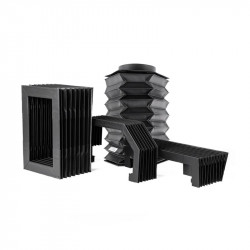
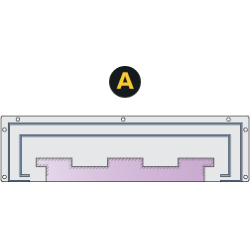
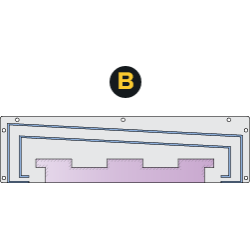
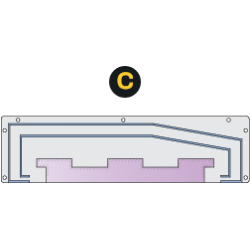
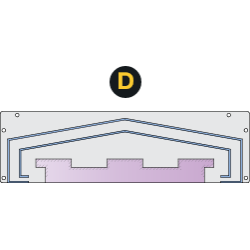
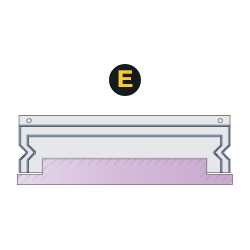
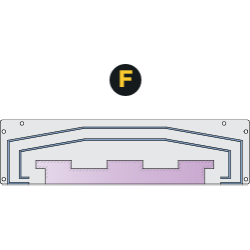
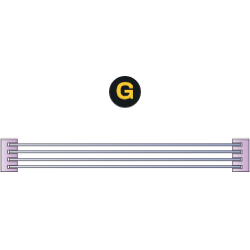
Оставить комментарий